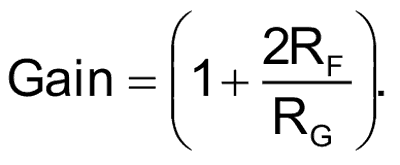Currently, all commercially available three-op-amp instrumentation amplifiers (in-amps) offer a single-ended output, but many applications could benefit from an in-amp with a differential output. Offering many advantages over its single-ended counterparts, a fully differential in-amp features increased immunity to common-mode noise sources, achieves lower second-harmonic distortion and higher signal-to-noise ratio, and provides an easy way to interface with modern differential-input ADCs.
Figure 1 shows the circuit implementation of a low-power, fully differential instrumentation amplifier formed by the cascade of an OP2177 precision low-power, dual op-amp (IC1) and an AD8476 fully differential amplifier/ADC driver (IC2). Drawing less than 1.2 mA of supply current, the composite amplifier has 11 nV/√Hz input noise, 2 nA maximum input bias current, 75 µV maximum input-referred offset voltage, and 0.9 µV/K maximum input referred offset voltage drift.
 |
|
| Figure 1. | Low power, fully differential instrumentation amplifier. |
The OP2177 and gain-setting resistors RF1, RF2, and RG form the in-amp’s preamplifier and set the amplifier’s voltage gain to:

If RF1 = RF2 = RF, then

The AD8476 serves as the in-amp’s subtractor; thus, it receives the amplified signal from the preamplifier, rejects its common-mode component, and passes its differential component. The AD8476 has a 90 dB common-mode rejection ratio (CMRR), enabling the in-amp to have 90 dB CMRR even at unity gain. At higher gains, errors induced by a common-mode input signal are further reduced by the preamplifier’s voltage gain when referred to the input.
Since the in-amp uses the three-op-amp topology, the match between discrete resistors RF1, RF2, and RG sets the amplifier’s gain accuracy – a parameter that can be easily calibrated – but does not limit the amplifier’s CMRR. The AD8476 also implements the in-amp’s differential output drive, allowing it to directly drive up to 500 kSa/s differential input ADCs. Optional network RZ – CZ forms a single-pole low-pass filter that can be used as an antialiasing filter.
The instrumentation amplifier’s output common-mode voltage is set by driving the AD8476’s VOCM pin. If this pin is left unconnected, the amplifier’s output common-mode voltage sits at mid-supply. When using the in-amp to drive an ADC, the AD8476’s VOCM pin should be connected to the common-mode voltage required by the ADC.